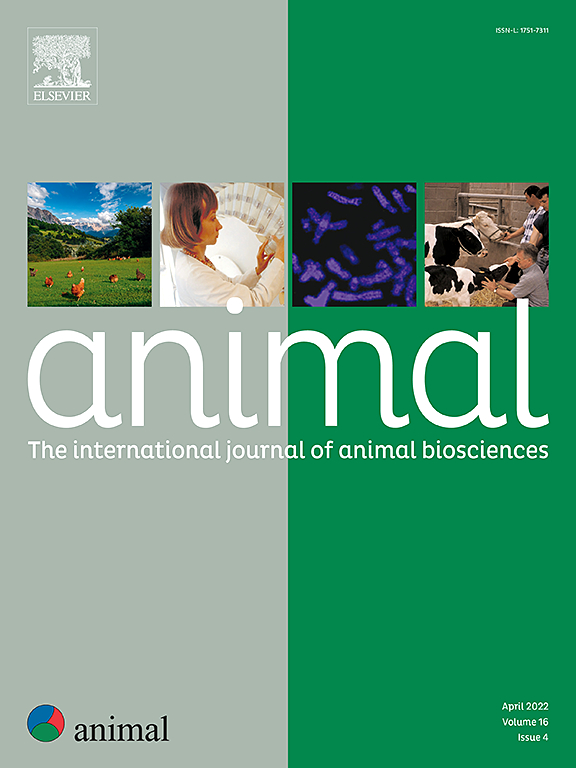Optimising compensatory growth in pastoral beef production systems: insights into feed efficiency, body composition, carcass characteristics and meat quality attributes
IF 4
2区 农林科学
Q1 AGRICULTURE, DAIRY & ANIMAL SCIENCE
引用次数: 0
Abstract
Exploitation of compensatory growth (CG) is a widely practised management strategy in beef production, especially under pastoral conditions due to its potential to reduce feed costs. The aim of this experiment was to evaluate the effect of nutritional restriction during backgrounding in Angus steers slaughtered at either similar age and/or similar BW on feed efficiency, body composition, carcass characteristics and meat quality attributes under either a forage or feedlot-based finishing diet. Eighty steers (BW: 444 ± 39 kg, age: 18 ± 1 months) were blocked and randomly assigned within block to either an optimal (0.6–0.7 kg/day) or suboptimal (0.3–0.4 kg/day) growth rate, during 97 days of backgrounding. Following, half of the steers in each group were finished on a forage diet while the other half were finished on feedlot-based diet. Half of the steers in each treatment were then slaughtered at similar age (24 months), whilst all remaining steers were slaughtered at similar BW (∼620 kg). Two extra slaughters were done with other representative steers on day 0 and day 97, to provide baseline parameters for carcass and non-carcass measurements. During the backgrounding period, optimal steers gained more than suboptimal (P < 0.01), resulting in higher BW and hot carcass weight (HCW; P < 0.01). During the finishing period, the suboptimal group increased BW gain (P < 0.01) and displayed an improved feed conversion ratio (FCR; P < 0.01). Differences (P < 0.01) in BW and HCW remained between the treatments when slaughtered at a similar age. When the steers were slaughtered at similar BW, after additional days of finishing for the suboptimal groups, no differences (P > 0.05) in backgrounding treatment on HCW, carcass grading, body composition or FCR for the entire period (backgrounding and finishing) were apparent. Indeed, no differences (P > 0.05) by backgrounding growth strategy were observed for any meat quality variables assessed using instrumental or sensory evaluations. During the finishing period, feedlot steers had increased (P < 0.01) BW and HCW gains, improved (P < 0.05) FCR and carcass grading, and had higher (P < 0.05) HCW compared to forage finished steers. However, no differences (P > 0.05) were observed for any meat quality variables assessed by finishing system. Overall, exploiting CG within pasture-based beef cattle production systems improves growth rate and FCR in both forage and feedlot finishing. Suboptimal backgrounded steers required additional days on feed to achieve similar BW to their contemporaries. Nevertheless, at similar BW, there were no residual differences in body composition, FCR during the entire period, meat tenderness or overall meat liking because of the backgrounding conditions.
优化田园牛肉生产系统的补偿性生长:饲料效率、体成分、胴体特性和肉质属性的见解。
利用补偿性生长(CG)是牛肉生产中广泛采用的管理策略,特别是在牧区条件下,因为它有可能降低饲料成本。本试验旨在评价饲粮型和饲地型育肥饲粮条件下,屠宰年龄相近和(或)体重相近的安格斯阉牛背景营养限制对饲料型和饲地型育肥饲粮中饲料效率、体成分、胴体特性和肉质特性的影响。80头肉牛(体重:444±39 kg,年龄:18±1个月)被分组,并在分组中随机分配到最佳(0.6-0.7 kg/天)或次优(0.3-0.4 kg/天)生长速率,为期97天。随后,每组各有一半饲喂饲料饲粮,另一半饲喂饲料基础饲粮。每个处理中有一半的阉牛在相近的年龄(24个月)屠宰,其余所有阉牛在相近的体重(~ 620公斤)屠宰。在第0天和第97天与其他有代表性的阉牛进行了两次额外屠宰,以提供胴体和非胴体测量的基线参数。背景饲喂期间,在HCW、胴体分级、体组成和FCR全期(背景饲喂和育肥期),背景饲喂处理的优肉牛显著高于次优肉牛(P < 0.05)。事实上,使用仪器或感官评估的任何肉质变量均未观察到背景生长策略的差异(P > 0.05)。育肥期各肉质指标均有显著提高(P < 0.05)。总体而言,在以牧场为基础的肉牛生产系统中利用CG可以提高饲料和饲养场育肥的生长率和FCR。次优背景饲主需要额外的饲粮天数才能达到与同时代饲主相似的体重。然而,在相似的体重下,在体成分、全期FCR、肉嫩度或整体肉喜度方面,没有因背景条件而残留的差异。
本文章由计算机程序翻译,如有差异,请以英文原文为准。
求助全文
约1分钟内获得全文
求助全文
来源期刊

Animal
农林科学-奶制品与动物科学
CiteScore
7.50
自引率
2.80%
发文量
246
审稿时长
3 months
期刊介绍:
Editorial board
animal attracts the best research in animal biology and animal systems from across the spectrum of the agricultural, biomedical, and environmental sciences. It is the central element in an exciting collaboration between the British Society of Animal Science (BSAS), Institut National de la Recherche Agronomique (INRA) and the European Federation of Animal Science (EAAP) and represents a merging of three scientific journals: Animal Science; Animal Research; Reproduction, Nutrition, Development. animal publishes original cutting-edge research, ''hot'' topics and horizon-scanning reviews on animal-related aspects of the life sciences at the molecular, cellular, organ, whole animal and production system levels. The main subject areas include: breeding and genetics; nutrition; physiology and functional biology of systems; behaviour, health and welfare; farming systems, environmental impact and climate change; product quality, human health and well-being. Animal models and papers dealing with the integration of research between these topics and their impact on the environment and people are particularly welcome.
 求助内容:
求助内容: 应助结果提醒方式:
应助结果提醒方式:


